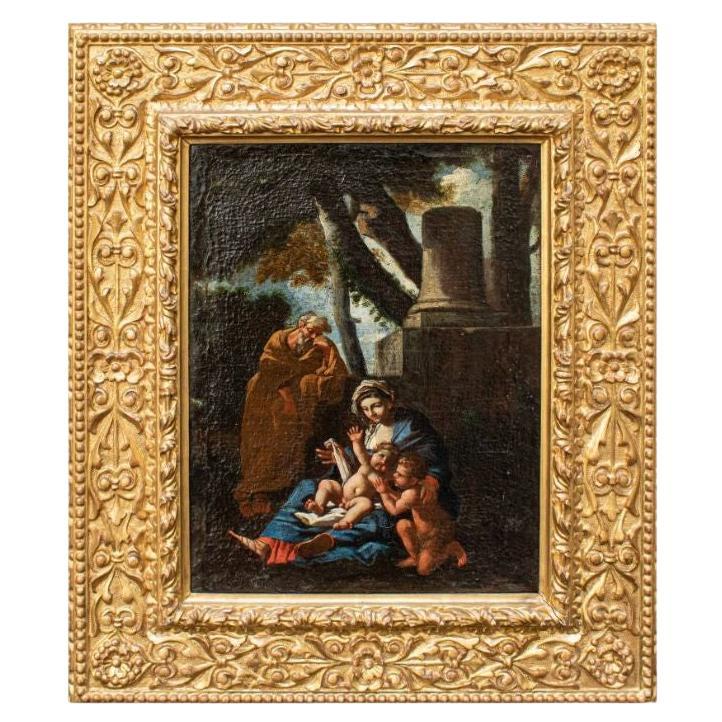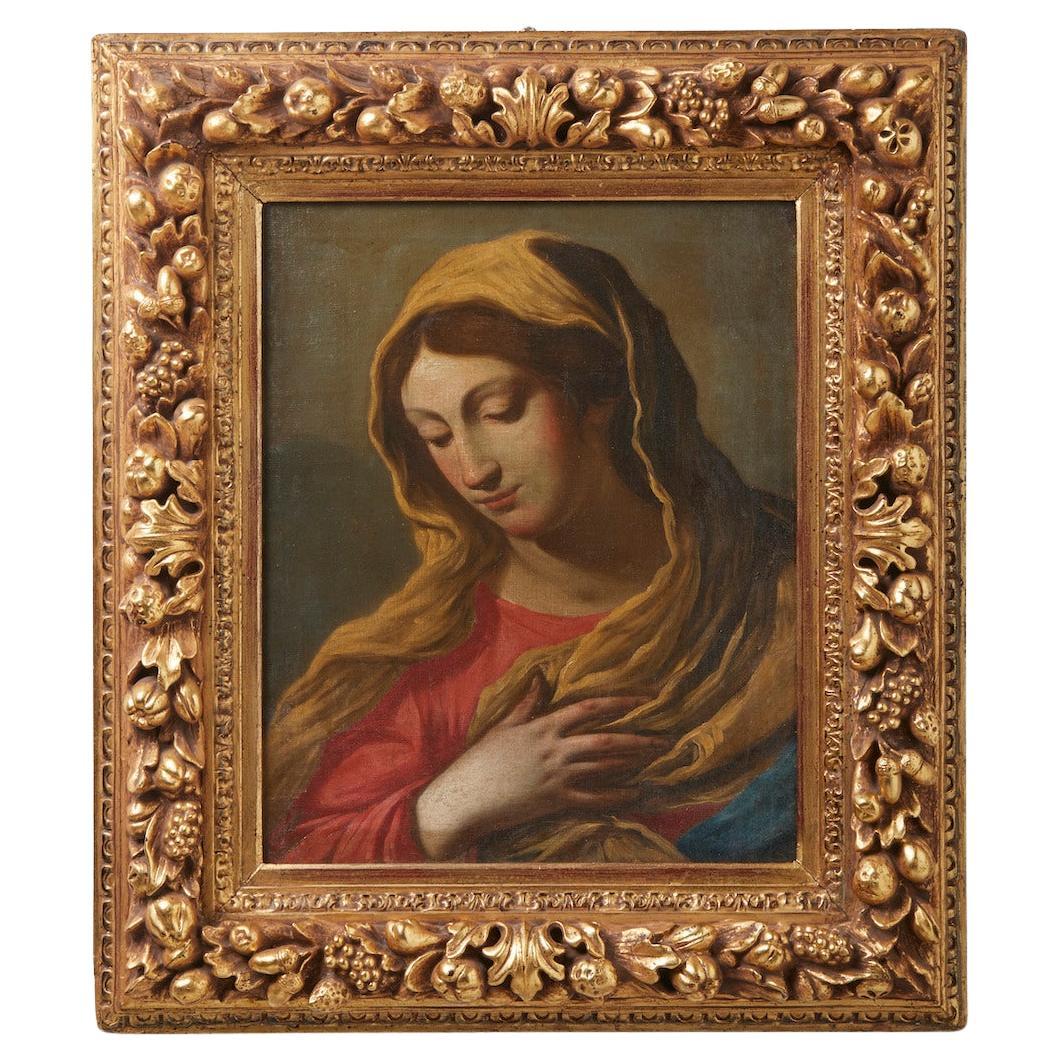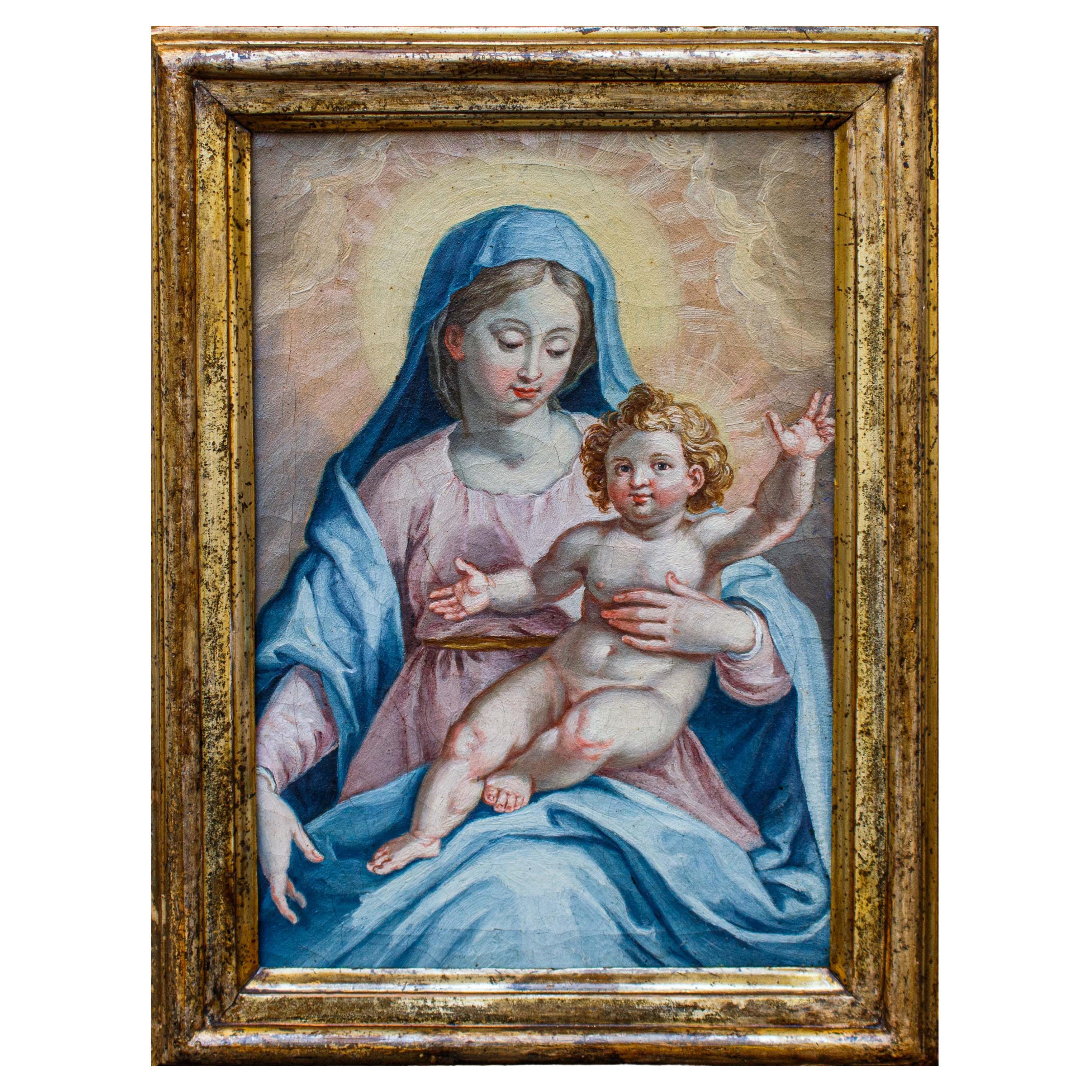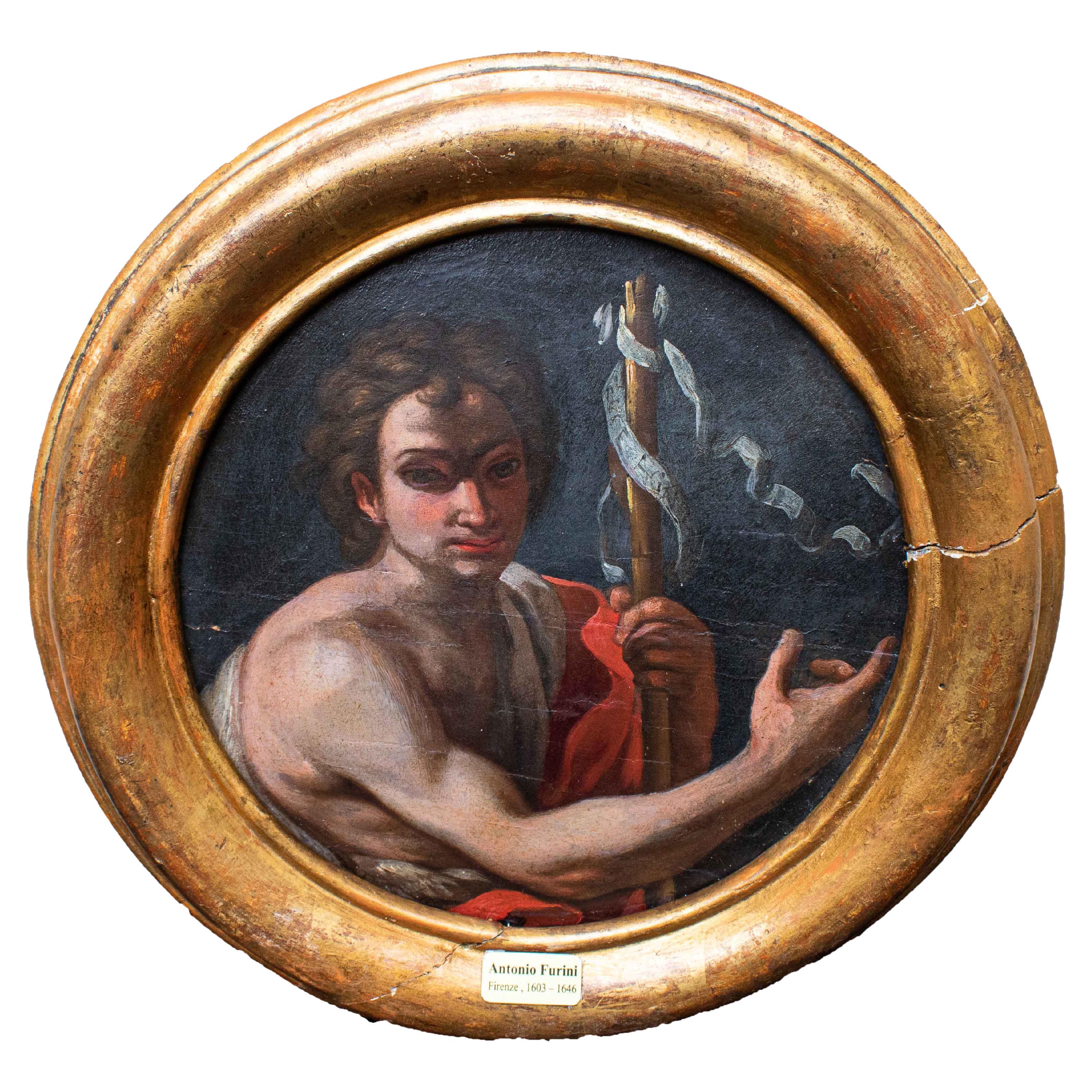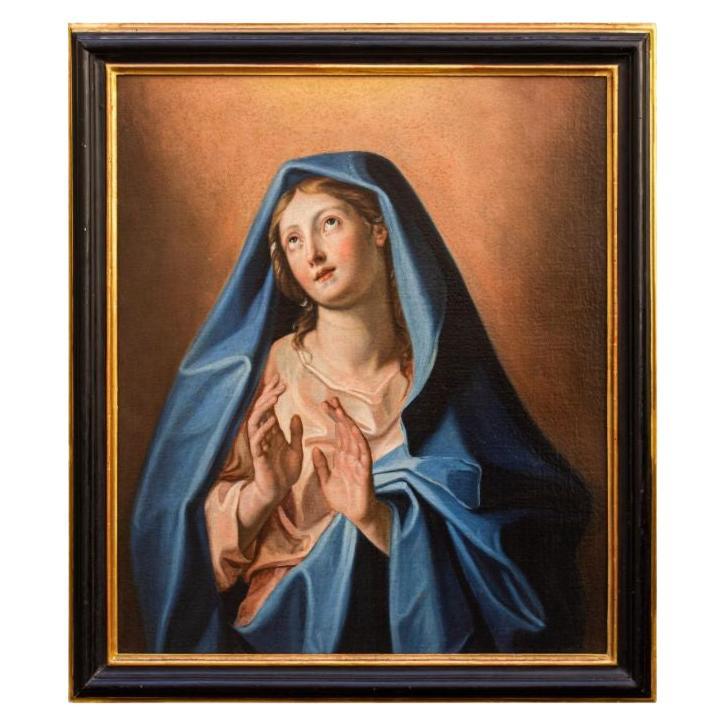Items Similar to 17th Century Putto with Rose Painting Oil on Canvas Emilian School
Want more images or videos?
Request additional images or videos from the seller
1 of 13
17th Century Putto with Rose Painting Oil on Canvas Emilian School
About the Item
Emilian school, 17th century
Putto with rose
Oil on canvas, 43.5 x 32 cm - with frame 45 x 32.5 cm
The figure of the putto, when equipped with specific attributes, lends itself to multiple iconological meanings. The present holds a delicate flower and at the same time gaily observes the viewer, spreading soft wings. A tender light illuminates the semblant, defining the volumes of the composition. Thus an elusive allegory of love is implied, to which the puttino is a preferential representative, and the crystalline flower, which resembles both a rose and a peony, emphasizes both the temporality of the feeling and the joy it brings. Even the open wings of the little putto, in addition to slender the figure through a slight dynamism, underline the immanence of the loving feeling, all-encompassing at a single time. The uncontaminated nature of the rose also interested the Christian world in the figurative arts, identifying with it the figure of the Virgin, called "Rose without thorns". In the pagan world the flower was related in particular to the goddess Venus, but the subsequent medieval reflection on it gave rise to many symbolic nuances, linked, as mentioned above, to time, love, truth and innocence.
The particular pink base, accorded to the specific amber skin of the child, allows to recognize an Emilian executive context, underlined, in old age, by the happy parable of Felice Fortunato Biggi (1680-1750), who re-proposed a similar Putto with flowers, today in Brescia private collection, in the middle of the 18th century, to testify the territorial appreciation of the subject. Simone Cantarini (1612-1648) re-proposed through technical virtuosity the same softness of the flesh in the figure of Jesus with the painting Madonna with Child and Saint Charles, now preserved at the Pallavicini Gallery in Rome; defined by Luigi Lanzi as “a great esteem for himself, contempt for everyone else”, the artist quickly became the most capable pupil of Guido Reni, importing the Emilian manner into the Marche region.
- Dimensions:Height: 17.72 in (45 cm)Width: 12.8 in (32.5 cm)Depth: 1.58 in (4 cm)
- Materials and Techniques:
- Place of Origin:
- Period:
- Date of Manufacture:17th Century
- Condition:Refinished. Wear consistent with age and use. The painting has been cleaned.
- Seller Location:Milan, IT
- Reference Number:1stDibs: LU5918226615872

About the Seller
5.0
Vetted Seller
These experienced sellers undergo a comprehensive evaluation by our team of in-house experts.
Established in 2000
1stDibs seller since 2021
25 sales on 1stDibs
Typical response time: 10 hours
- ShippingRetrieving quote...Ships From: Milan, Italy
- Return PolicyA return for this item may be initiated within 14 days of delivery.
More From This SellerView All
- 17th Century Rest on The Flight to Egypt Emilian school Painting Oil on CanvasLocated in Milan, IT17th century, Emilian school Rest on the flight to Egypt Oil on canvas, 42 x 33 cm Frame 65 x 55 cm The present Holy Family, ...Category
Antique 17th Century Italian Paintings
MaterialsCanvas
- 17th Century Rest on the flight to Egypt Emilian School Painting Oil on panelBy ParmigianinoLocated in Milan, IT17th century, Emilian school, Pamigianino painter Rest on the flight to Egypt Oil on panel, 46 x 39 cm - with frame 55.5 x 48.5 cm The wor...Category
Antique 17th Century Italian Paintings
MaterialsWood
- 17th Century Madonna with Child Painting Oil on Canvas Tuscan SchoolLocated in Milan, IT17th century, Tuscan school Madonna and Child Oil on canvas, 31 x 21 cm With frame, cm 37,5 x 27,5 The pearly incarnations and the thoughtful play of looks between the Virgin, turned to the Son, and Questi, warmly open to the viewer, pour out the present painting with compositional perfection. Virginal fabrics become mottled at the folds, wrapping the Madonna in a thin vitreous mantle. The pastel colors, shining on the pink robe just tightened at the waist by a gold cord, enliven the faces of the divine couple in correspondence of the cheeks, lit by an orange warmth. Even the left hand of the Virgin, composed in perfect classical pose (Botticelli, Madonna with Child, 1467, Musée du Petit Palais, Avignon), is sprinkled with warmth thanks to the immediate touch with Christ. From the nimbus of the Mother a delicate luminous disk is effused, which takes back, in the most distant rays, the colour of the hair of the Son, from the tones of the sun. The Child Jesus is represented intent in a tender gesture of invitation with the right hand, while with the other he offers a universal blessing: with his hand he retracts the index and annular palms, extending the remaining three fingers, symbol of Father, Son and Holy Spirit. The painting welcomes and re-elaborates that typically Tuscan formalism that boasted in the rest of Italy the constant appreciation by the most up-to-date artists and collectors. Arrangement, composition and mixing of colors place the canvas in the middle between the changing mannerist and the sculptural figures of Michelangelo, essential yardstick of comparison in terms of anatomical and expressionistic rendering. In the present, silvery and pinkish powders act as three-dimensional inducers to the Child’s mentioned musculature and to the vivid folds of the clothes, expertly deposited on the lunar whiteness of the skins. While these colours recall the equally brilliantly transparent colours of Pier Francesco Foschi...Category
Antique 17th Century Italian Paintings
MaterialsCanvas
- 17th Century St. John Baptist Florentine School Painting Oil on CanvasLocated in Milan, ITFlorentine school, 17th century St. John Baptist Oil on canvas, diameter cm 20 - with frame diameter 30 In this small round-format canvas, St. J...Category
Antique 17th Century Italian Paintings
MaterialsCanvas
- Early 17th Century Roman School Praying Madonna Painting Oil on CanvasLocated in Milan, ITRoman school, late 16th-early 17th century Praying Madonna Oil on canvas, 81 x 69 cm Frame 83 x 95.5 cm A divine whiteness reverberates with vibrant luster on the maphorion of the present Virgin. The palpable iridescence that structures the thin rosaceous garment, woven with the same fresh light, produces a slight rustle when she takes her hands off. The Madonna in fact takes a prayerful pose, opening her palms to underline her fervent ecstatic intention; the white neck is rendered with perishable fullness of pigments, like the hands, perfectly alive, and the very shiny eyes. With fine shrewdness the artist of the present styles the Virgin's hair with thin white ribbons, exacerbating the purity. An evocative light falls gently on the bust, a materialized sign of divine glory. The present can be traced back to the late Mannerist climate that prevailed in the capital after the emanation of the Tridentine council (1545-1563). The late Mannerist licenses that can still be seen there, such as the intense lyricism in the stylistic code adopted by the artist, are innervated in the new basic catechetical intent, which at the end of the century produced a certain figurative rigorism. The present, however, still responds to that extraordinary Roman dynamism that raised the capital to a bulwark for the entire mannerist lesson, matched only by a second artistic center, the Florentine one. The engaging carriage of the Virgin reflects the contemporary examples of Giuseppe Valeriano (1542-1596), a Jesuit painter, returning in the Marriage of the Virgin of the Roman Church of Jesus, as well as in the Madonna of Sorrows in the Recanati Altarpiece, equal ardor. But it is in the Assumption of the Virgin painted in four hands with Scipione Pulzone...Category
Antique Early 17th Century Italian Paintings
MaterialsCanvas
- 17th Century Live Nature Pair of Paintings Oil on Canvas Flemish SchoolLocated in Milan, ITFlemish School, 17th century Live nature couple with animals Measures: Oil on canvas, cm 25 x 35 - With frame cm 37 x 48 The pair of canvases in question depicts two excited...Category
Antique 17th Century Paintings
MaterialsCanvas
You May Also Like
- Virgin Annunciate, Emilian school, 17th century.Located in Brescia, ITVirgin Annunciate, Emilian school, 17th century. Oil painting on canvas depicting the Madonna, caught while, with her eyes half-closed and the right hand on his chest, receives th...Category
Antique 1680s Italian Baroque Paintings
MaterialsCanvas
- Oil on Canvas Paint Flemish School, 17th Century BelgiumLocated in Beuzevillette, FROil on canvas depicting a country scene: a man watering his horse near a river where two cows and a sheep wade accompanied by a farmer. Work of northern France or Belgium of the 17t...Category
Antique 17th Century Belgian Paintings
MaterialsCanvas
- Emilian School - Italy 17th Century "Four Still Lifes with Animals and Flowers"By Europa AntiquesLocated in Madrid, ESEmilian School - Italy 18th century - "Four Still Lifes with Animals and Flowers" oil painting on canvas Dimensions: 50x66 cm good conditionCategory
Antique Late 17th Century Italian Baroque Paintings
MaterialsPaint
- Early 17th Century Tuscan School Oil Painting on Canvas 'Virgin and Child'Located in NICE, FRWe present you this magnificent oil painting on canvas endearingly the Virgin Mary gently caressing the head of Christ Child asleep on His Mother's lap. This artwork has been expertly fit with new canvas and encased in an exquisite gilded wooden frame. It is representative of the Tuscan School...Category
Antique Early 17th Century Italian Baroque Paintings
MaterialsCanvas
- 17th Century Oil Painting On Canvas Depicting AgonizingLocated in Firenze, ITOil painting on canvas depicting Christ and the Madonna consoling a dying man, Emilian school, 17th century.Category
Antique 17th Century Italian Paintings
MaterialsCanvas
- 17th Century Still Life Oil Painting On CanvasLocated in Firenze, ITStill life oil painting on canvas depicting pumpkins, rabbits and chickens. Tuscany XVII century. The painting needs very small restoration. It has been relined.Category
Antique 17th Century Italian Paintings
MaterialsPaint
Recently Viewed
View AllMore Ways To Browse
Italian Oil Painting 17th
17th Century Italian Oil Painting
17th And 18th Century Oil Paintings
Antique Roses Oil Painting Paintings
Antique Rose Oil Painting
Antique Oil Painting Roses
Antique Rose Oil Paintings
Antique Christian Painting
17th Century Saint Paintings
Italian School Oil Painting 17th
Virgin Paint Oil On Canvas
17th Century Jesus
Amber Rose
Brescia Italy
Wings Reflection
Hand Painting Goddess
Guido Frame
Jesus Christian
